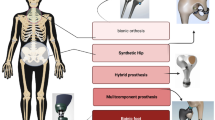Summary
Experiments have shown that stress shielding resulting from implantation of a prosthesis is related to the stiffness of the implant. Stiffness depends on the Young's modulus of the material used and the design of the implant. Most published studies have not attempted to define the relative importance of these two components. We have studied the influence of the elastic modulus only in an experiment using implants of a uniform design. Strain gauges were attached to the calcar in five femurs, three of which also had gauges placed on their medial, lateral and anterior aspects. Surface strain was measured in the intact femur and after implantation of cemented prostheses of the same design but manufactured with or without a collar in stainless steel or titanium alloy. The highest level of calcar strain was recorded with the titanium alloy prosthesis, and the presence of a collar appeared to increase the stress transfer of bone. This effect on stiffness was statistically significant, but was limited to the proximal part of the upper femur. It was not significant in the sub-trochanteric area, due to individual variations in bone geometry and cortical thickness. These results indicate that stress shielding can be directly related to the Young's modulus of the material used, independent of the design of the prosthesis.
Résumé
Il est acquis sur des bases expérimentales que le phénomène de déviation des contraintes (stress shielding) secondaire à la mise en place d'une prothèse articulaire est fonction de sa rigidité. Ce paramètre dépend simultanément de la nature du matériau utilisé et de la géométrie de l'implant. La plupart des études qui ont été réalisées dans ce domaine ont fait varier simultanément ces deux facteurs, aussi le but de cette étude est-il d'évaluer uniquement l'influence du module d'élasticité du matériau, sans faire varier la géométrie de la prothèse. Cinq fémurs ont été instrumentés avec des jauges de contrainte réparties sur l'éperon de Merckel et trois d'entre eux ont en plus été instrumentés sur leurs faces interne, externe et antérieure. Les déformations des os ont été mesurées sur l'os intact et après mise en place d'une prothèse cimentée en acier ou en alliage de titane, avec ou sans collerette. Le plus haut niveau de déformation de l'éperon de Merckel est obtenu avec les prothèses en alliage de titane; l'adjonction d'une collerette améliore la transmission des contraintes à l'os. L'effet rigidité est statistiquement significatif mais limité à la partie toute proximale du fémur; il n'est plus significatif dès la région sous-trochantérienne pour des raisons qui tiennent aux variations individuelles de géométrie et d'épaisseur corticale des os. Ces résultats montrent que la déviation des contraintes peut être directement liée au module d'élasticité du matériau utilisé, indépendamment de la géométrie de la prothèse.
Similar content being viewed by others
References
Christel P, Meunier A, Blanquaert D, Witvoet J, Sedel L (1988) Role of stem design and material on stress distributions in cemented total hip replacement. J Biomed Eng 10: 57–63
Cordey J, Perren SM (1985) Charges physiologiques sur les fémurs humains dans le plan frontal: estimation de la force appliquée par le tractus Ilio-Tibialis. J Biophys Biomec 9: 386–387
Crowinshield RD, Pedersen DR, Brand RA (1980) A measurement of proximal femur strain with total hip arthroplasty. J Biochem Eng 102: 230–233
Crowinshield RD, Brand RA, Johnston RC, Pedersen DR (1981) An analysis of collar function and the use of titanium in femoral prostheses. Clin Orthop 158: 270–277
Engelhardt JA, Saha S (1988) Effect of femoral component section modulus on the stress distribution in the human femur. Med Biol Eng Comput 26: 38–45
Engh CA, Bobyn JD (1988) The influence of stem size and extent of porous coating on femoral bone resorption after primary cementless arthroplasty. Clin Orthop 231: 7–28
Huiskes R (1979) Some fundamental aspects of of human joint replacement. Acta Orthop Scand 185 (suppl)
Lanyon LE (1984) Functional strain as a determinenant for bone remodeling. Calcif Tissue Int 36: S56-S61
Lewis JL, Askew MJ, Wixson RL, Kramer GM, Tarr RR (1984) The influence of prosthesis stem stiffness and of a calcar collar on stresses in the proximal end of the femur with a cemented component. J Bone Joint Surg [Am] 66: 280–286
Lord G, Marotte JH, Blanchard JP, Guillamon JL, Bancel P (1980) Valeur de l'assise horizontale et de l'appui diaphysaire dans la répartition des contraintes du fémur prothèsé. Rev Chir Orthop 66: 141–156
McLeish RD, Haboobi S (1972) Strain gauge techniques for cadaveric bone. Eng Med 1: 36–40, 47
Murphy SB, Schneeweis D, Walker PS (1985) Strain distribution and micromotion in press-fit and cemented hip prostheses. Orthop Res Soc 31: 119
Oh I, Harris WH, d'Errico J (1978) Effect of total hip replacement on the distribution of stress in the proximal femur: an in-vitro study comparing stress distribution in the intact femur with that after insertion of different femoral components. J Bone Joint Surg 60: 75–85
Pauwels F (1979) Biomécanique de l'appareil locomoteur. Springer, Berlin Heidelberg New York
Rohlman A, Bergmann G, Kolbel R (1981) Die Beanspruchung des Femurs. II. Einfluß des Tractus ilio tibialis. Z Orthop 119: 163–165
Rohlman A, Bergman G, Kolbel R (1981) The relevance of stress computation in the femur with and without endoprostheses. In: Gallacher RH, Simon BR, Johnson PC (eds) Finite elements in biomechanics, vol 2. Wiley, Chichester, pp 361–372
Svesnsson NL, Valliappan S, Wood RD (1977) Stress analysis of human femur with implanted Charnley prosthesis. J Biomech 10: 581–588
Tarr RR, Lewis JL, Jaycox D, Sarmiento A, Schmidt J, Latta LL (1979) Effect of materials, stem geometry, and collar-calcar contact on stress distribution in the proximal femur with total hip. Orthop Res Soc 25: 34
Author information
Authors and Affiliations
Rights and permissions
About this article
Cite this article
Meunier, A., Christel, P., Sedel, L. et al. Influence du module d'élasticité des tiges fémorales de prothèses totales de hanche et de la collerette sur la répartition des déformations du fémur. International Orthopaedics 14, 67–73 (1990). https://doi.org/10.1007/BF00183368
Issue Date:
DOI: https://doi.org/10.1007/BF00183368




